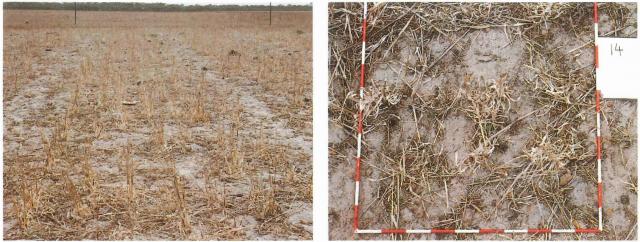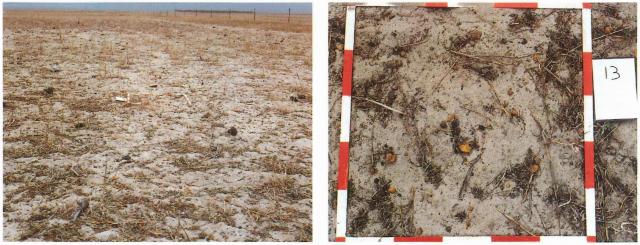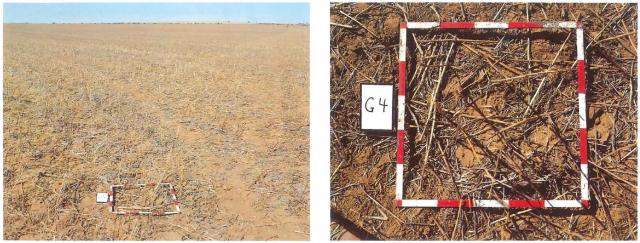Stubble levels to control wind erosion
Keep at least 50% ground cover to reduce the risk of wind erosion. Ground cover of 30% to 50% is a higher risk and might need additional management to prevent wind erosion. Less than 30% ground cover is a high risk, and will need additional management (see Managing wind erosion).
Targets for grazed stubbles
- Going to pasture, leave about 1500 kilograms per hectare (kg/ha) of anchored stubble after harvest. This will leave about 1000 kg/ha of anchored stubble by the beginning of autumn to give 50% cover during pasture establishment.
- Going to crop with full-cut seeding, leave about 2250 kg/ha of anchored stubble after harvest. This will leave about 1500 kg/ha of anchored stubble by the beginning of autumn to give 50% cover during crop establishment.
- Going to crop with zero tillage, leave about 1125 kg/ha of anchored stubble after harvest. This will leave about 750 kg/ha of anchored stubble by the beginning of autumn to give 50% cover during crop establishment.
Targets for ungrazed stubbles
- Going to pasture, leave about 1000 kg/ha of anchored stubble after harvest.
- Going to crop with full-cut seeding, leave about 1500 kg/ha of anchored stubble after harvest.
- Going to crop with zero tillage, leave about 750 kg/ha of anchored stubble after harvest.
The stubble should contain at least one-third anchored material, so that there is little movement of loose straw in strong winds and this movement is restricted to within the stubble paddock. If one third of the stubble is anchored, the straw will generally hold firm and maintain the coverage, even against gale-force winds.
How to use the photo-standards
There are 2 sets of photographs:
- Vertical photographs give the true picture of percentage ground cover.
- Oblique photographs (angle looking towards the horizon) give a more natural appearance of the stubble when viewed from some distance, but can give a misleading impression of much higher percentages of ground cover.
For cereal crops, 1000 kg/ha stubble corresponds to about 30–40% standing cover - the critical amount to prevent wind erosion. Because lupin stalks are heavier than cereals, about 2000 kg/ha of lupin stubble is needed to give the same protection.
The photostandards also show levels above and below the critical amount for cereals and lupins. Use the photostandards a month or two before the critical level will be reached in late summer to early autumn.
If you plan to crop the paddock, keep the amount of stubble after cultivation and seeding above the critical level. Tined seeding implements tend to bury about 30% of the existing stubble. This means that the amount of stubble remaining before cultivation should be greater than 1000 kg/ha for cereals and 2000 kg/ha for lupins.
Cereal
Click on each image pair to see it full-screen.
Lupins
Click on each image pair to see it full-screen.







